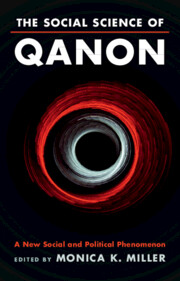Book contents
- The Social Science of QAnon
- The Social Science of QAnon
- Copyright page
- Dedication
- Contents
- Contributors
- Preface
- Part I Introduction to QAnon
- Part II Recruiting and Maintaining Followers
- Part III QAnon and Society
- Chapter 8 QAnon in the Year 2020
- Chapter 9 QAnon and the Politics of 2020
- Chapter 10 The QAnon Conspiracy Narrative
- Chapter 11 The Need to Belong
- Part IV The Role of Communication in Promoting and Limiting QAnon Support
- Part V The Future of QAnon
- Index
- References
Chapter 10 - The QAnon Conspiracy Narrative
Understanding the Social Construction of Danger
from Part III - QAnon and Society
Published online by Cambridge University Press: 14 September 2023
- The Social Science of QAnon
- The Social Science of QAnon
- Copyright page
- Dedication
- Contents
- Contributors
- Preface
- Part I Introduction to QAnon
- Part II Recruiting and Maintaining Followers
- Part III QAnon and Society
- Chapter 8 QAnon in the Year 2020
- Chapter 9 QAnon and the Politics of 2020
- Chapter 10 The QAnon Conspiracy Narrative
- Chapter 11 The Need to Belong
- Part IV The Role of Communication in Promoting and Limiting QAnon Support
- Part V The Future of QAnon
- Index
- References
Summary
Troublesome events are common in human groups, and humans respond to perceived dangerous situations by creating narratives that both give a name to the events and serve as one means of exercising control. We argue that conspiracy narratives are a distinctive type of danger narrative but also one that varies with the degree of alleged danger. These narratives are most likely to develop during periods of extreme social and cultural dislocation. QAnon is one in a succession of conspiracy narratives through American history, such as witchcraft narrative in 1692 Salem and the 1980s Satanic cult narrative, in which satanic figures are alleged to have invaded the everyday world with catastrophic results. It is a particularly important case as it can be analyzed in real time and it has reached an advanced level of narrative development. We identify core characteristics of advanced conspiracy narratives as revelatory framing, mythic themes, insurgent media network, and narrative radicalization. Narrative radicalization is particularly important as it involves blaming specific actors and attributing intentionality to their actions, which constitutes a bridge from narrative interpretation to social intervention.
Keywords
- Type
- Chapter
- Information
- The Social Science of QAnonA New Social and Political Phenomenon, pp. 159 - 175Publisher: Cambridge University PressPrint publication year: 2023
References
- 2
- Cited by

